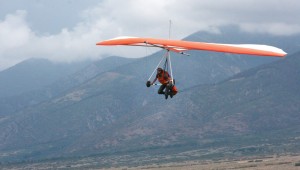By George Sibley
Earlier this summer a group of around 70 people, mostly from the Upper Gunnison River side of Central Colorado, enjoyed a tour of Blue Mesa Dam as part of a commemoration of the commencement of construction on the dam 50 years ago this summer. Bureau of Reclamation managers and engineers showed us around the dam and its powerplant, and we ended up staying an hour longer than anticipated, it was all so fascinating.
Just being down at the bottom of the Black Canyon is an experience in itself. This is a piece of the earth’s basement geology, rock purely from the fire at the heart of the planet streaked with twisting slashes of red and brown and black that lead one to imagine the tortured writhing of hell. That rock has been exposed by the erosive force of a river pulsing through in big snowmelt floods, working to remove it, and the mountains above it, working to again reduce the Rockies to a sea-level peneplain.
The dam is asserted into that happenstance primal rock-and-water contention, temporarily slowing or stopping the spectacular erosion. Compared to the rough walls of the canyon, it is a big, smoother, sloped plane of nubbled rock – three million cubic yards of carefully organized earth and rock, we learn from our guides. But even without their lesson, the intention of the dam in that place of random natural contention is obvious: it is not “natural,” not something that is just happening in reaction to other things happening.
Standing in front of the dam is a large concrete structure, as faceless as the dam itself. From up on Highway 92 on the crest of the dam looking down, it doesn’t look large, but down at the base of the dam, it looks huge – 40 or 50 feet high, maybe 150 feet long, windowless, but with a huge retracting door in one end. If one came across such a structure overgrown in a jungle or alone on a desert, one would immediately assume it were a temple from some ancient civilization, and wonder about a people who would build such a marvel, what power they worshipped there.
Those of us visiting the dam that day, of course, knew that this structure was indeed about power; somehow what that building contained, together with the dam, produced electric power. We were lucky that day; the dam was producing power. All we could really see of that process was the boil and bubble of water exiting the structure below where we stood, but we could feel the process, just by touching a railing or a wall: the entire big concrete structure was vibrating slightly under the force of what was going on there.
The Bureau guides took us through it all. The main floor was where rotors were spinning inside their stators in two generators each the size of a small house. Down a level to a small room we saw a spinning steel shaft the diameter of a medium tree. Down yet another level, we saw and felt the huge pipes (11 feet in diameter) that were carrying tons of water with all the force that water dropping a hundred feet or so can bring to the vanes of turbine, spinning it to spin the shaft that spun the rotors upstairs that sent the mystery of electricity into wires leaping nearly straight up out of the canyon to a transformer station, and from there out into our lives.
Dams have many critics today. It is hard, in fact, to imagine another major dam like this one being built in the United States, given our after-the-fact awareness of the ecological consequences of mainstream dams – changed flow and temperature regimes above and below the dam, reduced water quality due to evaporation, aquatic and riparian communities eliminated (including several human riparian communities under this reservoir), et cetera, et cetera. And the final judgment: “Besides, the reservoir is just going to fill up with silt over the next (choose a number) years, and then it’ll be useless.”
Indeed, and of course. And another millennial volcano could erupt somewhere in the neighborhood tomorrow and, in a matter of days or weeks rather than years, fill up not just the reservoir but the entire valley with a few hundred feet of ash compressed and cooled to rock, for water to again go to work on, turning it into the same thing again or something else. Natural systems themselves are nothing if not erratic and casual about disruptive ecological changes, and nothing, not even nature, builds for eternity. We humans alone seem to have the Old Testament illusion that creation was completed when we came along, and should forever be kept as it was then.
But – meanwhile, back down to that vibrating powerhouse deck – I remember thinking, even if one hates dams on rivers it would be hard to be unmoved in the presence of a big dam like Blue Mesa and the dynamism of its power plant. I felt, in fact, like asking the same question we ask about the people who built the pyramids or those temples subsumed in jungles around the world. What manner of people were those who built this? What beliefs, what kind of faith, led them to undertake projects on this scale?
Those people were, of course, just the parents and grandparent generations of us today. But somehow we do not seem to be quite the same people. I had given a brief talk on the bus trip to the dam about the Colorado River Storage Project, of which Blue Mesa and the other “Aspinall Unit” dams are just one part. A vast regional vision, most of which will, probably fortunately, never be built. An older woman on the tour – part of those generations – rattled off the names of some of the Colorado Congressional delegation in the 1950s, when the Storage Project Act was passed. “They were both Republicans and Democrats,” she said, “yet they could come together to get things like this done. It’s hard to imagine that today.”
It’s true: we have always had Democrats and Republicans, conservatives and liberals, reactionaries and progressives, but there have been times, prior to the 1970s, when their differences were mostly variant approaches to a shared vision that, for want of a more descriptive name, we called America. And they were usually eventually able to come up with some resolution of their differences that enabled them to construct concrete infrastructure for that shared vision. And when I say “concrete,” I mean that: concrete, steel, stone and brick, mountains of earth moved from here to there.
What they built were the systems that connect us all today as Americans – if we acknowledge them as such. The electric grid that this dam pours its power into, the most extensive highway system on earth, an ever-elaborating telecommunications system circling the planet, delivery systems that bring green vegetables to places like Gunnison in the dead of winter.
There is, however, a tendency today to take for granted these incredible systems – the infrastructure so absolutely foundational to our lives. As the Spanish philosopher Jose Ortega y Gasset put it, “The common man, finding himself in a world so excellent, technically … believes that it has been produced by nature.” The light switch has always been just there, like the trees and flowers; it works whether we consciously thank the dams and coal-fired plants that produce it, or curse them.
It isn’t just us common folk either; it is many of those who presume to offer us leadership at the state and national levels; they use their authority to deny the findings of scientists and the warnings of the managers of our technical systems. If they can be considered to be natural or God-given, they require nothing from us, so we can get down to the really important issues, like who should control the wombs of women, or how we descendants of immigrants should deal with immigrants today, or how much larger our military machine needs to be larger than those of the next 25 nations put together.
All of those complex systems that nurture our lives require constant maintenance, with occasional rebuilding of parts and sections. But we – supposedly the richest nation on earth – cannot find the common will to commit to that work (even though it could put a lot of people back to work, as the original construction did). We tie ourselves up in knots over the divisive questions above, and thus split and divided, destroy any hope of resurrecting the shared vision that would make us all, first, keepers of the systems we absolutely depend on – then innovators, improvers of them. “America” has become something we fight over, in a winners-and-losers environment. But, if or when these systems go down from lack of attention, we are all losers except for the Noah contingents preparing their arks of local communal systems.
But down there on the powerhouse deck at Blue Mesa Dam, there’s really no believing that usable electricity is “natural.” It is heavy, massive technology forcing a powerful cut-and-run river to stand in and push, and the natural power of the water is trying mindlessly to shake the system apart, just because that is what massed water does to things. To be there was a window on the magnitude of the systems we depend on. Hydropower is of course less than a tenth of the power poured into the grid that unites us all under a common power; waiting at a crossing for a hundred-car coal train to go by might be a better (if less scenic) window on that magnitude.
George Sibley is a writer living in Gunnison who thinks he might have made a better engineer.


